Isle of Man Rd 8+9: Anand finishes joint second!
With two rounds to go, Magnus Carlsen put the pedal to the metal in round 8 and sensationally won his game against Fabiano Caruana. This meant that he was beyond the reach of Anand even if the Indian won both his games. On the other hand, Vidit Gujrathi also drew his game against Pavel Eljanov and was also out of contention for the title. Nevertheless, the Indians fought hard and did the best they could before the tournament came to a close. Winning both of his last two games, Anand joined Nakamura in the second place; Vidit Gujrathi reached Elo 2721 in live ratings and climbed up to the 34th place in world rankings while Arjun Kalyan and Harsha Bharathakoti made an IM and a GM norm respectively. A report on the final two rounds.
Going into the penultimate round of the Isle of Man Open, as many as five players – including India’s Vidit Gujrathi – had the chance of catching Magnus Carlsen in the lead. In fact, they were right under his nose, just half-a-point behind.
Two other Indians, Vishy Anand and Swapnil Dhopade, also had an outside chance of catching the world champ. However, they were a full point behind. If Carlsen had drawn both of his next games and if Anand and/or Swapnil had won both of theirs, they might have been able to catch Carlsen. In fact, Magnus was going to face some tough pairings in his final two rounds, so the supposition wasn’t totally unrealistic.
But after the dust of round eight had settled, it was clear that none of this was going to happen. Magnus Carlsen had won his game against Fabiano Caruana. This instantly discarded any possibility of Anand or Dhopade catching him. But both Dhopade and Anand had won their games convincingly.
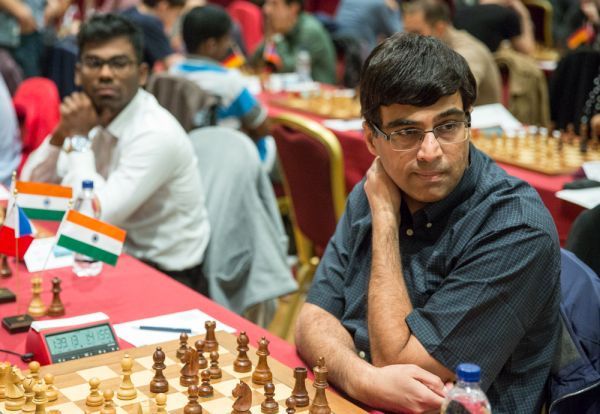
With the black pieces against Laurent Fressinet, this was not an easy task for Vishy. The Frenchman essayed the Italian Opening and the game got thematically positional. Both black’s, as well as white's queen's knight, took the theory stipulated journey to g6 and g3 respectively. Play was calm. But just then, Fressinet overextended his queen’s pawn and allowed Anand tremendous play on the queenside with his knight and rooks. A white pawn fell on the 33rd move. Anand now needed to defend his passer on the queen rook file. The pawn was placed under the defence of both rooks on a4. The other black knight then travelled over to c5 from the king’s side. There wasn’t much to play for anymore. Fressinet knew the rooks will be coming in now and he was going to be dead lost. He cut his suffering short, therefore, and resigned.
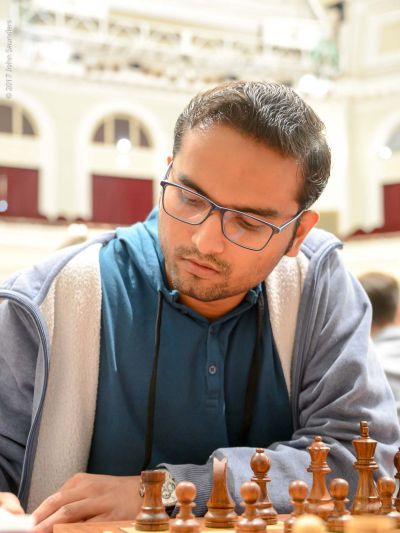
In the game of Swapnil Dhopade against GM Nigel Short, the former got a pleasant position out of the opening. With his well-posted knights on the queenside, Dhopade exchanged queens and went into a favourable endgame. Thanks to his active pieces, Dhopade was won a couple of pawns after some accurate play. On the 50th move, knights were exchanged. The position was dead lost for black by now. A rook and pawn endgame was reached. Short tried to create play by pushing his only remaining pawn. But this was blocked easily by Swapnil’s king and then the Indian’s three pawns began rolling down. The Pune Grandmaster gave a nice finishing touch to the game with a temporary rook sacrifice to force his pawns to the last rank and seal the game in his favour.

While Anand’s and Dhopade’s wins will surely improve their overall standing in the tournament, they were now out of the race for the title. There was still Vidit though. If the Nashik lad won his game, he would still be in contention. He was playing with the white pieces against the defending champion of the event, Pavel Eljanov. The two played a Queen’s Indian Defence in which neither player was able to secure an advantage for himself. Pieces were traded at regular intervals and the players reached a rook and bishop endgame which was absolutely equal. As soon as they reached move 30, players agreed to a draw.

With his draw, Vidit moved up to six points. This gave Nakamura the opportunity to move up the tournament leaderboard. His game against Emil Sutovsky featured the Queen’s Gambit Accepted. Sutovsky, who had the black pieces, went into ultra-aggressive mode from the word go. Sacrificing a pawn in the opening, Sutovsky tried to trap Naka’s queen. But this eventually backfired as Naka was able to break through on the queenside and force Sutovsky’s king in the centre, denying him the right to castle. Soon one of Sutovsky’s bishop was trapped on the kingside and was about to be hacked off the board, not to mention he was already a pawn down and had the worse pawn structure. By the 31st move, Sutovsky had seen enough and resigned.
Nakamura was the only one among the five players, who were chasing Carlsen, to keep his chances alive. Not only had he put himself in the sole second place, but he had also earned the right to play Carlsen in the final round. This ensured it will be one of these two players who will be lifting the champion’s trophy after the final round.
In the finale
After Naka's back to back wins in the seventh and the eighth round, he was really going for it. He had had an excellent run so far. He had remained unbeaten throughout the event, was in good form, and had even earned the right to play the tournament leader in the final round. There was every reason for him to play for a win. There was only one problem though: he had the black pieces. Therefore, choosing the right opening was of paramount importance.
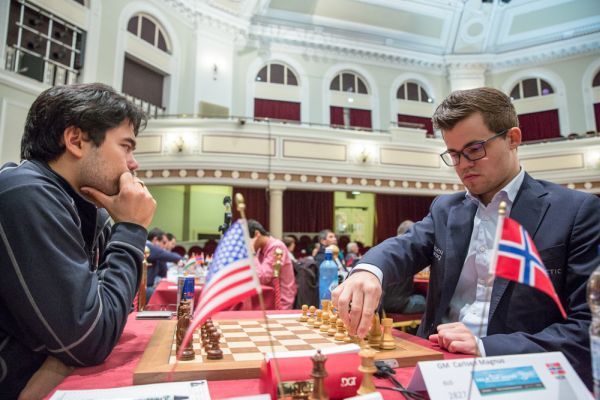
The game began, Carlsen played 1. d4. Naka replied with the Queen's Gambit. The 5. Bf4 line appeared. By the 12th move itself, Naka knew what was coming. Magnus had a way to force a draw by repetition in the position. But there wasn't much he could do now. If he chose to play on by not repeating, his position would be much worse. On move 18, the players were seen shaking hands. Nakamura was visibly unhappy.

After the game, Nakamura said that going for the King's Indian Defence was definitely an option. But he felt Carlsen must have also considered that he might play it and chose to go for this line. But once 12. Qc1 was on the board, there was hardly anything he could have done.
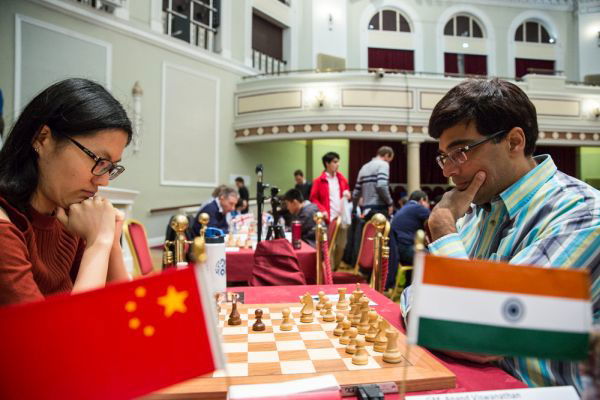
Yifan, with the black pieces, opened with the Petroff, an opening known for leading to drawish positions. By the 12th move, the position was almost completely symmetrical. The difference being, the placement of the light and dark squared bishops of white and black respectively. As IM Sagar Shah pointed out in his post-game analysis, this is what gave Anand a slight edge in the position. Making the most of such a minuscule edge, Anand did everything in his might to improve his pieces. Finally, on move 25, Anand's efforts were rewarded. A tactic involving a knight sacrifice won Anand a pawn. This was good enough for the five-time world champion to convert. He finished the game off with impeccable technique by move 53. Do watch IM Sagar Shah's video below for a detailed analysis.
But Anand wasn't the only Indian who made his countrymen proud with his performance in Douglas. The finale of the event brought glory to many others like Vidit Gujrathi, Swapnil Dhopade, Harsha Bharathakoti etc.
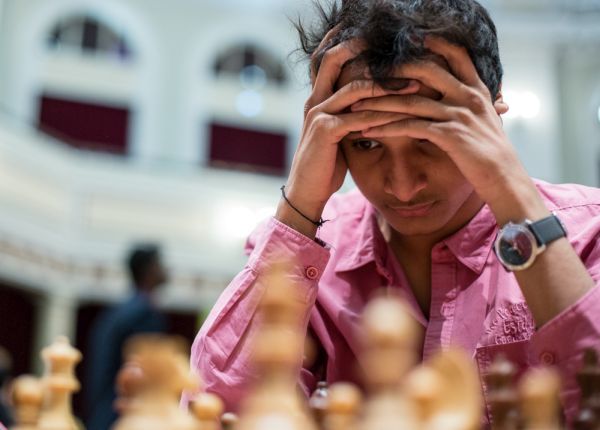
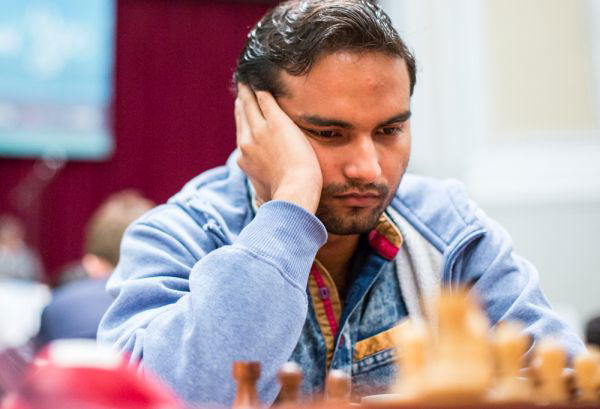


Round 9 Results

Final Standings

Previous reports
Round 01: Random pairings adorn round one with interesting matchups
Round 02: Top seeds feel the heat
Round 03: Kramnik suffers a shocking loss
Round 04: Vidit joins Carlsen and company in the lead
Round 05: Indian young guns shine
Round 06: Vidit moves up to clear second spot
Round 07: Tournament remains wide open after Vidit holds Carlsen to a draw
Coverage on Firstpost
Round 01: Viswanathan Anand, Magnus Carlsen too strong for opponents, Vidit Gujrathi held
Round 02: Magnus Carlsen digs deep to eke out win, Viswanathan Anand forces a draw
Round 03: Viswanathan Anand roars back to form; Harika Dronavalli holds higher-rated Nils Grandelius
Round 04: Vidit Gujrathi outwits Benjamin Bok, joins Magnus Carlsen in seven-way tie for top spot
Round 05: SP Sethuraman stuns Boris Gelfand; Harsha Bharathkoti continues impressive run
Round 06: Vidit Gujrathi ends Harsha Bharathkoti's run; Viswanathan Anand trounces SP Sethuraman
Round 07: Vidit Gujrathi holds tournament leader Magnus Carlsen, remains joint second after Round 7
Round 08: Viswanathan Anand essays comprehensive win, Vidit Gujrathi settles for draw in Round 8

